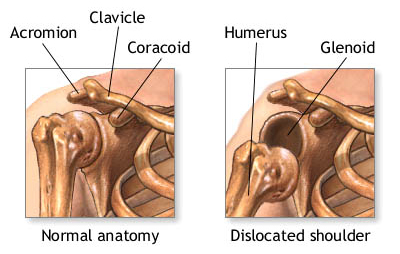Symptoms of a Dislocated Shoulder
Shoulder dislocation is a relatively common injury in a wide variety of sports. Generally, when a shoulder is dislocated, the head of the humerus (the upper arm bone) is forced forwards when the arm is turned outwards and being held out to the side. This dislocation, known as an anterior dislocation, makes up approximately 95% of all shoulder dislocations.

Posterior are the second most common type of dislocation with 3% or dislocations being posterior. The other 2% of dislocations include inferior dislocations, superior dislocations, and intra thoracic dislocations. Regardless of their classification, all dislocations can also cause a variety of complications and damage to surrounding structures such as muscles, tendons, or nerves.
The anatomy of the shoulder allows for a wide range of motion, but this also makes the joint more prone to dislocation. As a result, the shoulder is the most commonly dislocated joint, followed by elbow, knee, finger and wrist dislocations.
When a shoulder dislocation occurs, the shoulder anatomy may become damaged to the point where the joint is less stable. When this happens, shoulder dislocations can become a reoccurring problem, and the risk of causing damage to the joint is greatly increased.
To reduce the risk of repeated dislocations, it is recommended that patients see a medical professional immediately following the initial dislocation. A medical professional should also be the one to re-position the shoulder, as improper technique can cause considerable damage to the joint and cause futher problems in the future.
Dislocated Shoulder Symptoms
* Injury is usually acute, produced by direct or indirect trauma such as a fall * A sudden onset of severe pain * Shoulder feels like it has ‘popped out’ * Shoulder will look noticeable different, usually loosing the smooth, rounded shape. * Patient feels the need to hold the arm close to their body to reduce movement * A ‘pin and needle’ feeling, numbness, or discoloration may occur if there is severe nerve or blood vessel damage






